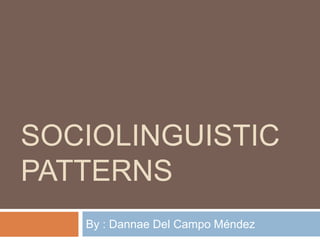
Sociolinguistic patterns12
- 1. SOCIOLINGUISTIC PATTERNS By : Dannae Del Campo Méndez
- 2. Language and Social Class Educatio Social n Class Ocuppatio n Age Income Sociolinguist ics Network Sex Style
- 3. Sociolinguistic Patterns External Regional Patterns Patterns Social Class Migration Age Sex Style Urbanization Network
- 4. Sociolinguistic Variables -Phonological Variables: 1.- Postvocalic /r/ England > The loss of /r/ following by a consonant but not a vowel. USA > The distribution of postvocalic /r/ reflects the history of settlement patterns (colonists) from Britain.
- 5. ing : alveolar /n/ nasal /ŋ/ - Lower person’s social status uses alveolar /n/ /h/ : alternation between /h/ and a lack of /h/ - Urban accents do not have initials /h/ (heart, hill, etc..) - Grammatical Variables: - The variable concerns the use of non-standard third person singular present tense verb form without –s e.g he go.
- 6. Style Forma Inform l Style Dependin al Style g on : Social Context, Relationship of the participants, Social Class, Sex, Age, Physical Environment and Topic.
- 7. Gender Woman Men -Women use higher status variants ( postvocalic /r/ and – ing ). -Tend to hypercorrect (more than man). -Use more prestige forms. -Women are more concerned with politeness. * Hypercorrection: non-standard usage from the over- application of a rule of grammar.
- 8. Age Younger /t/ variable: speakers use Marker of more standard social class forms than membership young adults. amng adult and school age population.
- 9. Social Network People with whom we interact are a Different socializing powerful source habits of individuals of influence on speech. and their degree of involment in the local community. • Is the one in which people whom a Dense given speaker knows and nteracts Network with also know each other. • Is the one in which the individuals Multiplex who interact are tied to one Network another in other ways.
- 10. Standardization One of the main agents of Process: inequality Convert one variety into a The aim is to remove standard by variation and stablish fixing and ONE system to serve regulating its as a uniform one for a spelling, group. grammar, etc... The process has never be regarded as complete.